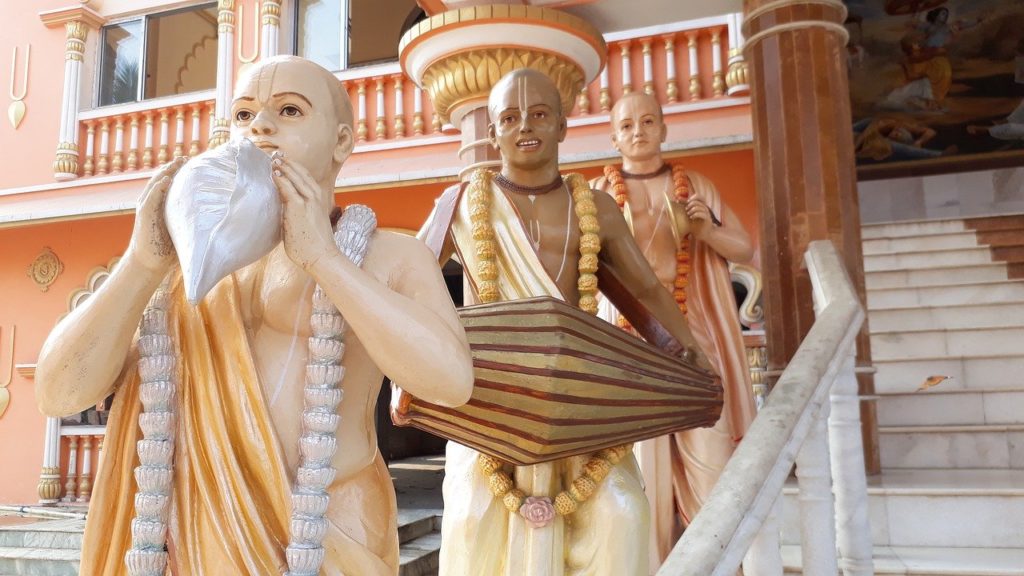
Sri Rupa Goswami, foremost of the six Goswamis of Vrindavana, delineates the actions that help boost one’s devotional life and those that serve as impediments hindering one’s spiritual progress. He writes in his ‘Nectar of Instructions’ that associating with worldly-minded people, who are not drawn to devotion, is one such action that is detrimental to spiritual progress (jana sangas ca laulyam ca sadbhir bhaktir vinashyati). He therefore urges a serious devotee of Lord Krishna to renounce such material association in order to achieve success in his/her spiritual endeavors (sanga tyagat sato vritteh sadbhir bhaktih prasidhyati). The Vedic Literatures are full of such evidences that establish the sublime benefits of associating with a Vaishnava (Sadhu Sanga). Spirituality fosters in the association of devotees while materialistic company promotes materialistic pursuits. Hence the wise choose their association carefully acknowledging that their consciousness is affected by the company they keep.
Spirit and matter are fundamentally opposed to each other. One can either live in spiritual or else in material consciousness. Likewise, material and spiritual attachments are inversely proportional to each other. Lord Krishna, the Supreme Lord, is the master of countless potencies.
parasya saktir vividhaiva sruyate – His energies are innumerable and immeasurable (Svetasvatara Upanishad 6.8)
These potencies can be grouped primarily into internal, marginal, and external. The internal energy of the Supreme Lord constitutes the eternal, blissful, and cognizant spiritual world. Those who possess a spiritual consciousness and seek the shelter of the Supreme Lord fall within the purview of the Lord’s internal energy (Hladini shakti). On the other hand, this temporary world of matter falls within the purview of the Lord’s external energy (Bahiranga shakti). The living entities of this world, however, belong to a third category. They belong to the marginal potency or the ‘tatastha shakti’ of the Supreme Lord. ‘Tata’ refers to the region between land and water, and hence it holds the properties of both. Therefore ‘tata’ cannot be referred to as belonging purely to either land or water. Similarly, the living entities of this world have a choice to be attracted to either the world of spirit or the world of matter. Though the living entity is a part and parcel of the Supreme Lord and spiritual by nature, yet sometimes it may become overwhelmed by this temporary world of dull matter.
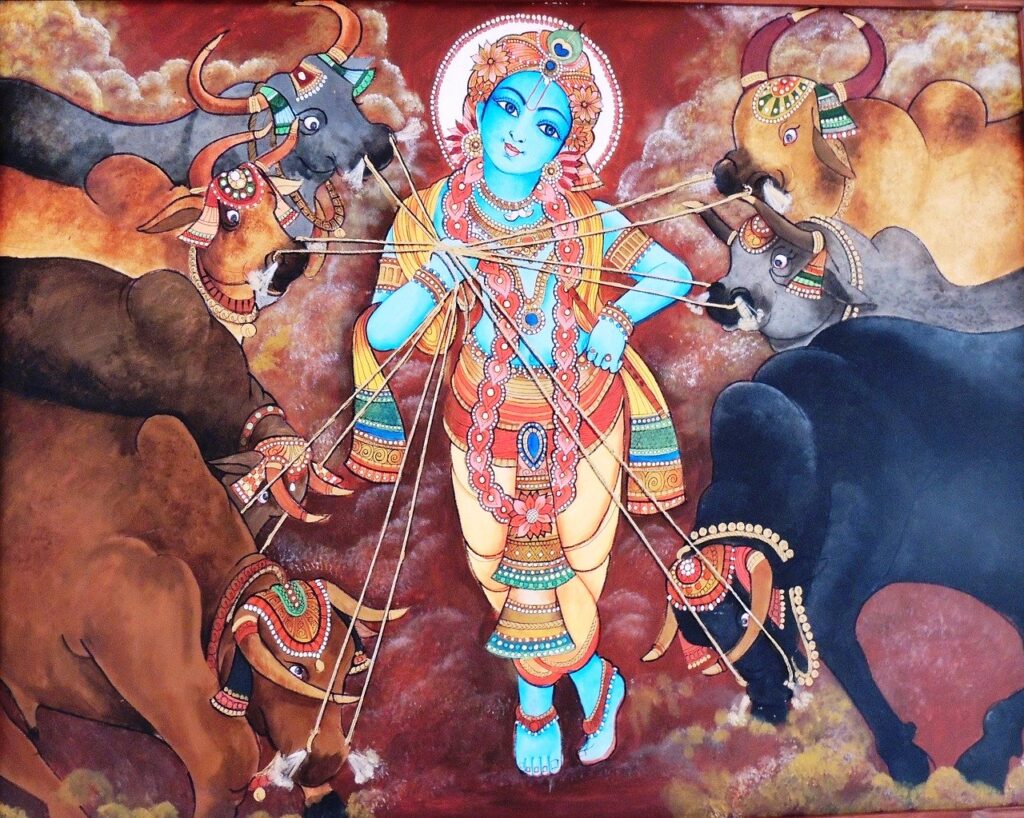
Those living beings who grow bewildered by the illusory energy (Maya) of the Lord and consequently try to enjoy this temporary material world, become controlled by the external potency (bahiranga shakti) of the Supreme Lord. These unfortunate souls deviate from their constitutional position as a servant of the Supreme Lord and indulge in sense gratification by trying to Lord over matter. However, their efforts only die in frustration as flickering sensual pleasures can never fully satisfy a living being who is eternally hankering for pure spiritual bliss. On the other hand, those wise living entities (devotee of Krishna), who choose to engage in the devotional service of the Supreme Lord become controlled by the Lord’s internal energy (Hladini shakti).
In the absence of the association of pure devotees, it becomes exceedingly hard for a living entity to escape the external energy of the Supreme Lord. The Bhagavad Gita teaches how this material energy of the Lord is exceedingly difficult for a living being to overcome on his own (mama maya duratyaya). But this incredibly challenging objective is easily accomplished by those who surrender unto the Supreme Lord and seek His divine shelter (mam eva ye prapadyante mayam etam taranti te). Such a fortunate soul is rare in these three worlds. The association of devotees assumes great significance in this regard as it reminds a living entity of the grave misfortunes of leading a materialistic life and helps him pursue the ultimate objective of engaging in devotional service of the Supreme Lord. That is why even the great Vaishnava poet Narottama das Thakura hankers for the association of devotees and sings – ‘grihe ba vanete thake, ha Gauranga bole dake, Narottama mange tara sanga’ (Narottama das seeks the association of one who calls out the name of ‘Gauranga’ with love. It does not matter if such a person stays in his house or being renounced, stays in the forest).
Pastimes that demonstrate the importance of associating with a Vaishnava (Sadhu Sanga) and avoiding the association of Non-devotees
A devotee named Kala Krishna das accompanied Sri Chaitanya Mahaprabhu on His tour of South India (Chaitanya Charitamrita, Madhya, Ch 9). But unfortunately, he deviated from Mahaprabhu’s personal service being allured by the Bhattatharis (gypsies) who were then living in the region of Mallara-Desha (the area around northern Kerala and southern Karnataka). Bhattatharis are a nomadic community who pose as sannyasis but whose real business is stealing and cheating. The Bhattatharis take the help of their women to entice others to cheat them. Kala Krishna das associated with these nomadic people and fell into their trap. On being requested to return Kala Krishna das, the Bhattatharis attacked Lord Chaitanya with their weapons. However, owing to Mahaprabhu’s divine will, the weapons fell off their hands and struck their own bodies. Finally, Chaitanya Mahaprabhu grabbed Kala Krishna das by his hair and rescued him by pulling him away. Chaitanya Mahaprabhu later rejected Kala Krishna das due to his fall down.
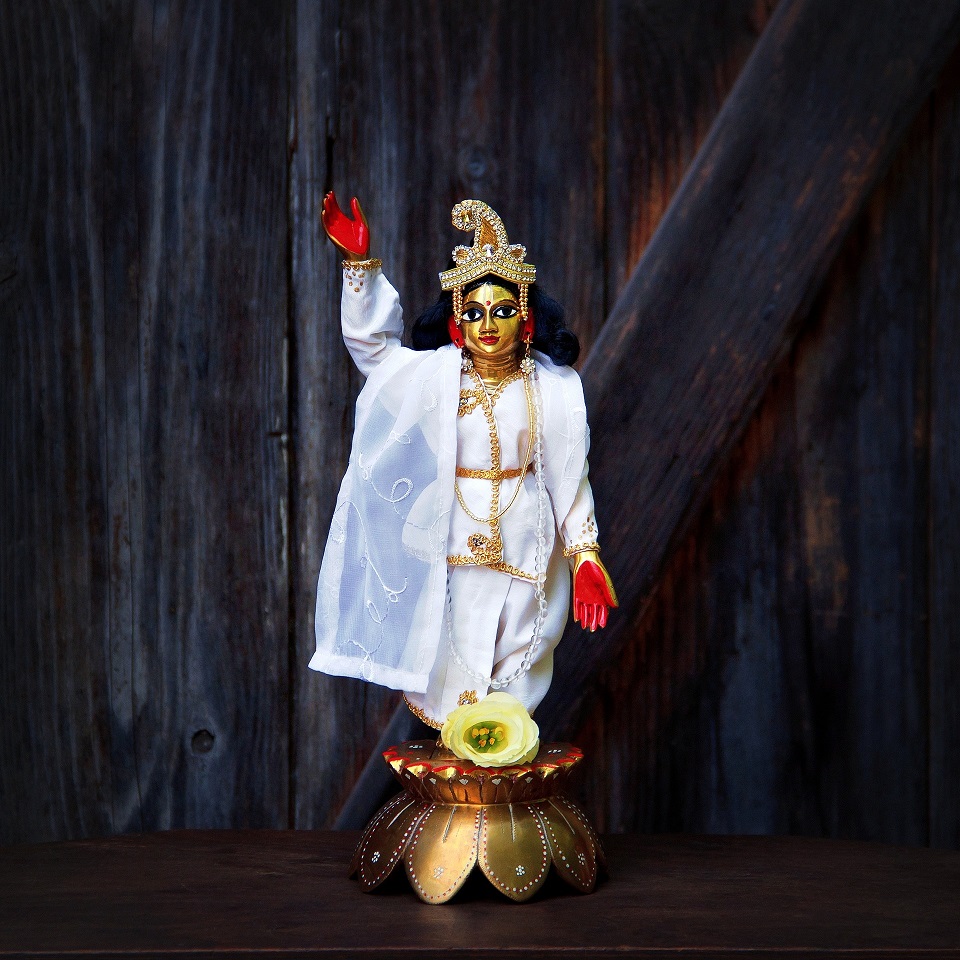
On the other hand, the scriptures are full of pastimes that exhibit the power of devotee association. For instance, dacoit Ratnakara was transformed into sage Valmiki, coming in association with Narada muni, an exalted devotee of Krishna. Valmiki went on to compose the great epic Ramayana that is replete with enchanting pastimes of Lord Rama and His dear devotees.
In the pastimes of Namacharya Haridasa Thakura (Chaitanya Charitamrita, Antya, 3.99-144), we observe how the prostitute Lakshahira (Hira bai) who had come to seduce and defame Haridasa, met with a change of heart. Associating with Haridasa Thakura, a pure devotee of Lord Krishna, and hearing him chant the holy names of Krishna for three consecutive days, purified her and raised her consciousness. She acknowledged her crime and later accepted initiation from Thakura Haridasa. She distributed her wealth, shaved off her head, and spent the rest of her life engaging herself in the service of Lord Krishna.
Gangadhara Bhattacharya, the father of Srinivasa acharya, was one of those who had the rare opportunity to witness Sri Chaitanya Mahaprabhu’s sannyasa initiation at Gauranga bari ,in Katwa (ref – Bhakti ratnakara, ch 2). It was very heartbreaking for those present, to witness Lord Chaitanya ,whose beauty surpassed that of a millions of moons, shave off His beautiful hairs and accept the robes of a renunciant. At the same time, those present were immersed in a wave of ecstasy, being able to behold the Lord’s beautiful form, and His captivating intoxicated mood. Such was the purifying effect of catching a glimpse of Lord Chaitanya and witnessing His sannyasa, that Gangadhara began chanting Sri Chaitanya’s names day and night. He constantly cried “Ha Chaitanya! Ha Chaitanya! Krishna Chaitanya!”. Such was his intoxication in divine love for Mahaprabhu, that people nicknamed him as Chaitanya Das. This is how, being a recipient of Lord Gauranga’s mercy, Sri Gangadhara Bhattacharya came to be subsequently known as Chaitanya Das. He and his wife Lakshmipriya devi were blessed by Lord Chaitanya, and as a result these fortunate souls could subsequently become the proud parents of Sri Srinivasa Acharya, the manifestation of Chaitanya Mahaprabhu’s ecstasy.

Srimati Narayani devi was showered with special mercy by Lord Chaitanya while she was just a little child. Once while Sri Gaurasundara was manifesting His divine pastimes at Srivasa Angana, He ordered little Narayani, who was then just four years old, to chant the holy name of Lord Krishna and cry in ecstasy. Receiving the Lord’s mercy and His divine association, little Narayani immediately chanted the holy names and fainted onto the ground, being overwhelmed with ecstatic emotions. Tears of love streamed down her eyes, and flooded the ground. Sri Chaitanya Mahaprabhu was the supreme Lord (Krishna) Himself who had advented in the mood of a devotee of Krishna. This pastime with Narayani devi has been very nicely captured by Srila Vrindavana Das in Chaitanya Bhagavata –
Sarva-Bhuta antaryami Sri Gauranga Chand
Agnya kaila ‘Narayani Krishna bali kand’
Chari batsarer sei unmatta carita
‘Ha Krishna’ baliya matra parila bhumita
Anga bahi pare dhara prithibira tal-e
Paripurna haila sthala nayaner jal-e
(Sri Chaitanya Bhagavata)
Narayani devi later gave birth to Srila Vrindavana das Thakura, the original Vyasadeva of Lord Chaitanya’s pastimes. Srila Vrindavana das is the composer of Chaitanya Bhagavata, the enchanting biography of Sri Chaitanya Mahaprabhu.
Sri Chaitanya Mahaprabhu has set a precedent on how one should be exceedingly eager to associate with devotees. At the same time, one should carefully avoid the association of non-devotees. Chaitanya Mahaprabhu used to engage in ecstatic sankirtana with devotees every night at the house of Srivasa Pandita. Sri Advaita, Haridasa, Srivasa, Mukunda Datta, Gadadhara, and several other devotees accompanied the Lord in these divine pastimes. All of these pastimes took place behind closed doors denying the smartas (ritualistic brahmanas) and the atheists of Nabadwip the opportunity to witness them. These materialists, however, gathered outside the gate and spent their time criticizing the Lord and His sankirtana. But no matter how hard they tried, and how much chaos they created, Sri Chaitanya was exceedingly careful in not allowing them to associate with the devotees or His intimate pastimes. In one such instance, Srivasa Pandita even dragged his mother-in-law out of the house when she was found hiding at a corner hoping to witness Mahaprabhu’s ecstatic dance.
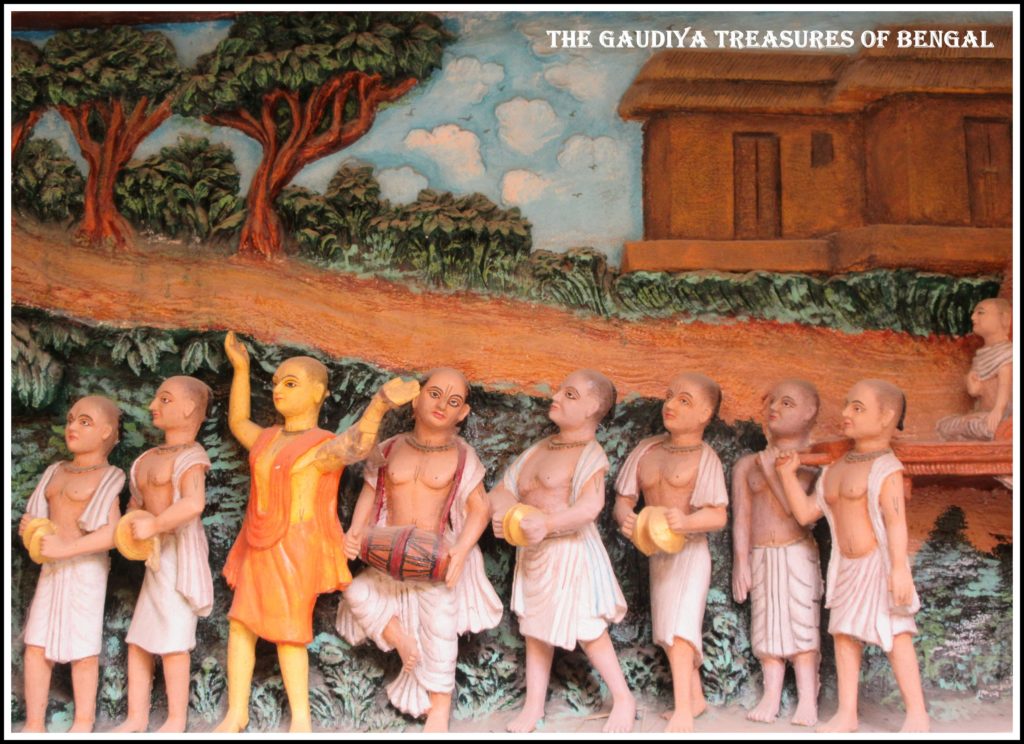
Likewise, during the Mahaprakash Lila (sath prahariya Lila), Sri Chaitanya Mahaprabhu initially refused to bestow His mercy upon Mukunda Datta as he was prone to associating with the Mayavadis (Advaita Vedantists). In this way, Chaitanya Mahaprabhu stressed the importance of associating with devotees and at the same time taught us how associating with non-devotees can serve as an impediment in our devotional lives.
Associating with pure devotees of Lord Krishna is emphasized throughout the revealed scriptures. In the Madhya Lila of Chaitanya Charitamrita, it is proclaimed that even a moment’s association with a pure devotee of the Lord bestows all success.
sadhu-sanga, sadhu-sanga sarva sashtre kaya
lava-matra sadhu-sange sarva-siddhi haya
(Chaitanya Charitamrita,Madhya, 22.54)
Receiving the association of devotees (Vaishnavas) is an outcome of causeless mercy
Srila Narottama das Thakura sings :
ara kabe Nitai-cander koruna hoibe
samsara-basana mora kabe tuccha ha’be
visaya chariya kabe suddha habe mana
kabe hama herabo sri-vrindavana
–
When will I obtain the mercy of moon-like Lord Nityananda? When will the fire of my material desires get extinguished?When will my mind become free from material desires and anxieties? I shall then be able to behold the spiritual abode of Vrindavana
It must be noted that without receiving the mercy of the Lord or the spiritual master, one cannot grow in his/her spiritual life or come into the association of devotees. This principle is highlighted in the above prayer by Narottama das Thakura as well. In this song, he prays to Lord Nityananda, the original Guru, for relieving him of his material entanglement and empowering him to behold the highest spiritual realities.
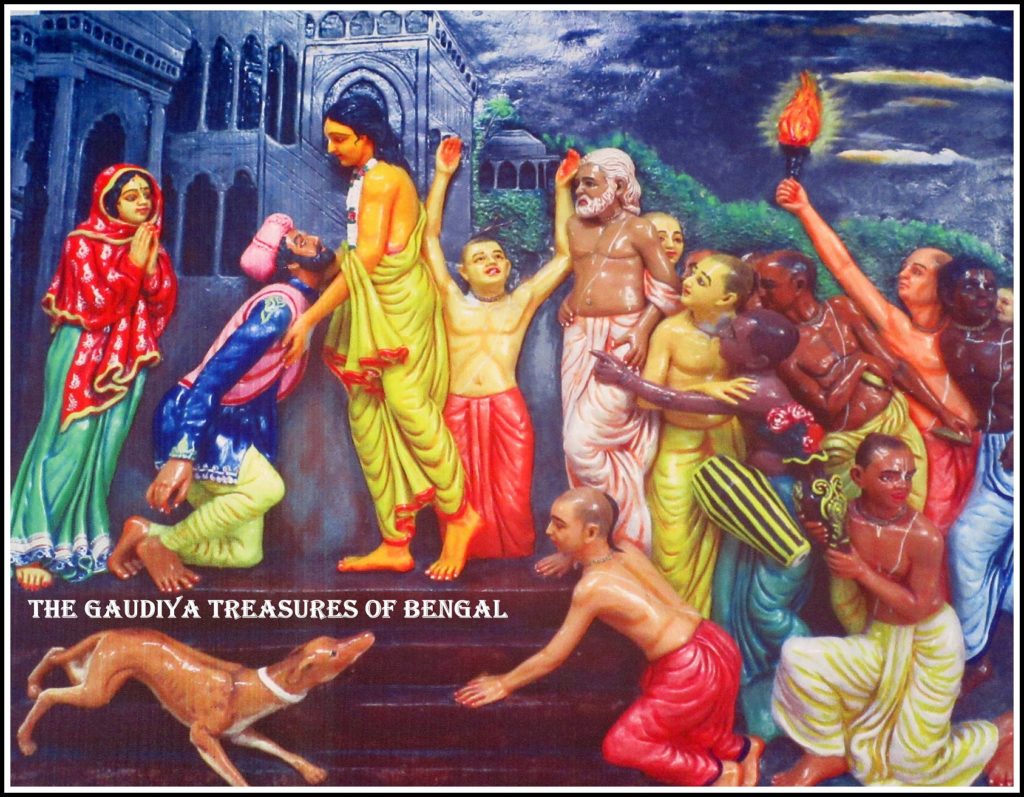
Sri Raghunath das Goswami, the prayojana acharya of our sampradaya, was the son of a landlord. He tried to leave his home on several occasions. He was driven by an intense desire to associate with the devotees and serve with them full-time. However, his attempts to escape the clutches of his family met with frustration on all occasions. This was until he was blessed by Lord Nityananda and His associates at Panihati. Raghunath’s desires came to be fulfilled and he soon obtained the lotus feet of Lord Chaitanya and the association of devotees at Jagannath Puri.
Similarly, Srila Krishnadas Kaviraja Goswami, the composer of Chaitanya Charitamrita, could obtain the shelter of the six Goswamis and the great fortune of residing at Vrindavana dham, only after receiving the causeless mercy of Lord Nityananda (Chaitanya Charitamrita,Adi,5.181).
Therefore the mercy of the spiritual master is the secret to sustaining our spiritual lives and staying in the association of devotees. His causeless mercy is our only hope in crossing over this vast ocean of material suffering and eventually obtaining the lotus feet of Krishna (jahara prasade bhai e bhava toriya jai, krishna-prapti hoy jaha hoite).